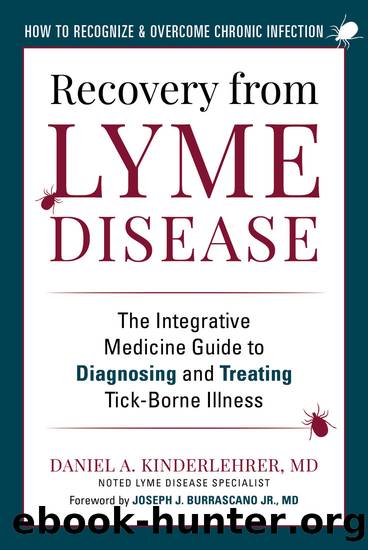Recovery from Lyme Disease by Daniel A. Kinderlehrer

Author:Daniel A. Kinderlehrer
Language: eng
Format: epub
ISBN: 9781510762060
Publisher: Skyhorse
Published: 2021-03-02T16:00:00+00:00
MEDICAL MARIJUANA
Now is a good time to talk about medical marijuana (MMJ). MMJ has been legalized in the majority of states and in the District of Columbia, although states vary in the types of medical conditions approved for its use. Marijuana has 483 phytocannabanoids, which are naturally occurring compounds that can affect many body processes such as appetite, mood, and sleep. Most people have heard of one of themâTHC, or tetrahydrocannabinol, the psychoactive component of marijuana. It has been clearly established that THC is quite beneficial for pain, sleep, nausea, appetite, and PTSD, so there are numerous medically valid reasons for its use.48
Most of the remaining phytocannabanoids are cannabadiols (CBDs).
There are two strains of cannabis: indica and sativa. The difference between the two strains are terpenes, which modulate the activity of THC and CBD. For example, indica is effective for pain but can be sedating, so it is best used evening and nighttime. Sativa is also pain-relieving, but is activating and may increase energy, so it is better suited for daytime use. There are now a profusion of hybrid strains available that essentially cross categories.
CBDs were once considered physiologically inactive unless paired with THC, but it turns out that is not the case. There is a compelling amount of scientific research documenting their independent activity, and increasingly there is extensive clinical experience as well.
It turns out that we make our own CBDs. All vertebrates going back 600 million years on the evolutionary tree have an endocannabanoid system which modulates immune and nervous system function. CBDs are potent anti-inflammatory agents, they regulate neurotransmitters, and they may enhance immune competence. CBDs decrease neuroinflammation and are neuroprotective. They can significantly reduce pain and anxiety.49,50,51
CBDs can be extracted without THC, particularly when obtained from hemp, which is a strain of Cannabis sativa but is not a controlled substanceâit is legal everywhere and can be purchased on the Internet. If the problem is pain, consider CBDs in the form of hemp oil in the daytime. It has less than 0.3 percent THC, so there is no psychoactive or sedating effect. My patients have had excellent responses to both oral capsules and a liposomal sublingual extract (taken under the tongue), and it is activating, sometimes increasing energy. Conversely, CBD helps sleep in some people, probably secondary to its impact on reducing anxiety. In some patients it helps cognition.
In the evening, a marijuana extract with equal parts THC and CBD will have additive pain-relieving effects. There are a number of delivery systems available, including smoking, vaping, edibles, and sublingual extracts. I recommend the extracts since the onset is reasonably quick, usually less than thirty minutes, and the dose can be easily titrated by the number of drops under the tongue.
Both hemp-derived CBD and marijuana are available as salves that can be applied topically to relieve pain. Whether taken systemically or applied locally, many patients are able to decrease the need for pain medication.
It is notable that states that have legalized medical marijuana have experienced a 25 percent decrease in opiate overdose deaths.
Download
This site does not store any files on its server. We only index and link to content provided by other sites. Please contact the content providers to delete copyright contents if any and email us, we'll remove relevant links or contents immediately.
| Administration & Medicine Economics | Allied Health Professions |
| Basic Sciences | Dentistry |
| History | Medical Informatics |
| Medicine | Nursing |
| Pharmacology | Psychology |
| Research | Veterinary Medicine |
Periodization Training for Sports by Tudor Bompa(7929)
Why We Sleep: Unlocking the Power of Sleep and Dreams by Matthew Walker(6362)
Paper Towns by Green John(4805)
The Immortal Life of Henrietta Lacks by Rebecca Skloot(4262)
The Sports Rules Book by Human Kinetics(4079)
Dynamic Alignment Through Imagery by Eric Franklin(3925)
ACSM's Complete Guide to Fitness & Health by ACSM(3827)
Kaplan MCAT Organic Chemistry Review: Created for MCAT 2015 (Kaplan Test Prep) by Kaplan(3805)
Introduction to Kinesiology by Shirl J. Hoffman(3629)
Livewired by David Eagleman(3535)
The River of Consciousness by Oliver Sacks(3421)
The Death of the Heart by Elizabeth Bowen(3342)
Alchemy and Alchemists by C. J. S. Thompson(3298)
Descartes' Error by Antonio Damasio(3167)
Bad Pharma by Ben Goldacre(3102)
The Emperor of All Maladies: A Biography of Cancer by Siddhartha Mukherjee(2934)
The Gene: An Intimate History by Siddhartha Mukherjee(2929)
The Fate of Rome: Climate, Disease, and the End of an Empire (The Princeton History of the Ancient World) by Kyle Harper(2878)
Kaplan MCAT Behavioral Sciences Review: Created for MCAT 2015 (Kaplan Test Prep) by Kaplan(2822)
